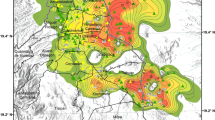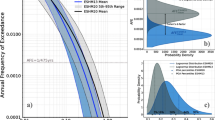Abstract
This article presents probabilistic seismic hazard analyses of northern Pakistan region carried out to produce macro-seismic hazard maps for the region that define new regional ground motion design parameters for 95-, 475-, 975- and 2475-year return period earthquakes as regional contour maps and horizontal uniform hazard at important cities. The Cornell–McGuire approach (Cornell in Bull Seismol Soc Am 58(05):1583–1606, 1968; McGuire in FORTRAN computer program for seismic risk analysis. US Geological Survey, Open file Report, 76-6768, 1976) is used to carry out the analyses at 0.1° rectangular grid. The seismotectonic model of the region used in analysis consists of shallow and deep area zones differentiated based on the focal depths of the earthquakes. Earthquake catalogue compiled and used in the analysis is a composite catalogue composed of 19,373 events. Ground motion prediction equations (GMPEs) used are calibrated using goodness-of-fitness measures and visual inspection with local strong motion data. Epistemic uncertainty in the GMPEs is taken into account through the logic tree approach. Comparison of ground motions due to deep earthquakes is made for the first time for the region. The comparison between ground motion due to shallow and deep earthquakes indicates that the seismic hazard would be underestimated if the deep earthquakes are excluded. Ground motion values obtained in this study considering all the earthquakes suggest ground motions are dominant towards the north east of the region. The proposed study indicates that the ground motion hazard values suggested by the current Building Code of Pakistan underestimate the seismic hazard. Final results of this study are in close agreement with the recent studies on the region.






















Similar content being viewed by others
References
Akkar S, Bommer JJ (2006) Influence of long-period filter cut-off on elastic spectral displacements. Earthq Eng Struct Dyn 35(9):1145–1165
Akkar S, Bommer JJ (2010) Empirical equation for prediction of PGA, PGV and Spectral Acceleration in Europe, the Mediterranean region and the Middle East. Seismol Res Lett 08(02):195–206
Akkar S, Kale Ö, Yenier E, Bommer JJ (2011) The high-frequency limit of usable response spectral ordinates from filtered analogue and digital strong-motion accelerograms. Earthq Eng Struct Dyn 40:1387–1401
Ambraseys NN (2000) Re-appraisal of north-Indian earthquakes at the turn of the 20th century. Curr Sci 79:1237–1250
Ambraseys NN, Melville C (1982) A seismic history of persian earthquakes. Cambridge University Press, Cambridge
Ambraseys NN, Bommer JJ (1991) The attenuation of ground accelerations in Europe. Earthq Eng Struct Dyn 20:1179–1202
Ambraseys NN, Douglas J (2004) Magnitude calibration of north Indian earthquakes. Geophys J Int 159:165–206
Apel E, Burgmann R, Nagarajan B (2006) Geodetically constrained Indian plate motion and implications for plate boundary deformation. Eos, Transactions, American Geophysical Union 85, 52 T51B-1524 Fall meeting supplement
Atkinson MG, Boore MD (2003) Empirical ground motion prediction relations for subduction zone earthquakes and their application to Cascadia and other region. Bull Seismol Soc Am 04(04):1703–1729
Akkar S, Douglas J, Di Alessandro C, Campbell KW, Somerville PG, Cotton F, Silva W, Baker, J (2012) Defining a consistent strategy to model ground motion parameters for the GEM-PEER Global GMPEs Project. In: 15th world conference on earthquake engineering, Lisboa, Portugal
Ambraseys N, Bilham R (2003) Earthquakes in Afghanistan. A report on earthquake catalog for Afghanistan
Bahatia SC, Kumar MR, Gupta HK (1999) A probabilistic seismic hazard map of India and adjoining region. Annali di Geofisica 42(06):1153–1164
Bilham R, Wallace K (2006) Future Mw > 8 earthquakes in the Himalaya: implications from the 26 Dec 2004 Mw = 9.0 earthquake on India’s eastern plate margin. http://cires.colorado.edu/~bilham/HimalayanEarthquakes/KangraCentenaryFinal.htm
Bindi D, Luzi L, Mass M, Pacor F (2010) Horizontal and vertical ground motion prediction equations derived from the Italian Accelerometric Archive. Bull Earthq Eng 08:209–237
Boore DM, Atkinson GM (2008) Ground motion prediction equations for average horizontal PGA, PGV and 5% damped PSA at spectral periods between 0.01 s and 10.0 s. Earthq Spectra 24(01):99–138
Building Code of Pakistan: Seismic Provisions (2007) Ministry of Housing, Govt. of Pakistan
Cauzzi C, Faccioli E (2008) Broadband (0.05 to 20 s) prediction of displacement response spectra based on the worldwide digital records. J Seismol 12:453–475
Chiou B, Youngs RR (2008) A NGA model for average horizontal component of peak ground motion and response spectrum. Earthq Spectra 24(01):173–215
Cornell CA (1968) Engineering seismic risk analysis. Bull Seismol Soc Am 58(05):1583–1606
DeMets C, Gordon RG, Argus DF, Stein S (1994) Effect of recent revisions to the geomagnetic time scale on estimates of current plate motions. Geophys. Res Lett 21:2191–2194
EZ-FRISK software for earthquake ground motion estimation, version 7.62. Risk Engineering, Inc, USA
Giardini D et al. (2014) Earthquake model of middle east region: hazard, risk assessment, economics and mitigations, final project report
Gardner JK, Knopoff L (1974) Is the sequence of earthquakes in California, with aftershocks removed, Posssonain. Bull Seismol Soc Am 64(05):1363–1367
Grunthal G, Wahlstrom R (2003) An Mw based earthquake Catalogue for central, northern and northwestern Europe using a hierarchy of magnitude conversions. J Seismol 07(04):507–531
Hashash YMA, Kim B, Olson SM, Ahmad I (2012) Seismic hazard analysis using discrete faults in northwestern Pakistan: part II—results of seismic hazard analysis. J Earthq Eng 16(08):1161–1183
Joshi GC, Sharma ML (2008) Uncertainties in the estimation of Mmax. J Earth Syst Sci 117(S2):671–682
Kale O, Akkar S (2013) A novel procedure for selecting and ranking candidate ground motion prediction equations for seismic hazard analysis: Euclidean distance based ranking (EDR) method. Bull Seismol Soc Am 103(2A):1069–1084
Kanno T, Akria N, Morikawa N, Fujiwara H, Fukushima Y (2006) A new attenuation for strong ground motion in Japan based on recorded data. Bull Seismol Soc Am 96(03):879–897
Khan MA, Sayab M (2012) Preliminary report on seismic zones of Pakistan Earthquake Model of Middle East Region mid –Term report
Kolathayar S, Sitharam GT (2012) Characterization of regional seismic source zones in and around India. Seismol Res Lett 83(01):77–85
Kolathayar S, Sitharam TG, Vipin KS (2012) Spatial variation of seismicity parameters across India and adjoining areas. Nat Hazards 60(3):1365–1379
Lai GC, Bozzoni F, Zuccolo E, Corigliano M, Scandella L (2012) Probabilistic seismic hazard assessment in east Caribbean islands, European Centre for Training and Research in Earthquake Engineering, Report, /01
Lin P, Lee C (2008) Ground motion attenuation relationships for subduction zone earthquakes in northeastern Taiwan. Bull Seismol Soc Am 98(01):220–240
McGuire RK (1976) FORTRAN computer program for seismic risk analysis. United States Geological Survey, Open file Report, 76–6768
McGuire RK (2004) Seismic hazard and risk analysis. Earthquake Engineering Research Institute, Oakland
Molnar P, Tapponnier P (1975) Cenozoic tectonics of Asia: effects of continental collision. Science 189(4201):419–426
MonaLisa, Khawaja AA, Jan MQ (2007) Seismic hazard assessment of NW Himalayan thrust and fold belt, Pakistan, using probabilistic approach. J Earthq Eng 11(2):257–301
Musthaq Y, Khan MA, Waseem M, Rafi Z (2012) Evaluation of global attenuation relationship in light of Pakistan specific strong motion data. J Himal Earth Sci 45(2):119–120
Nath SK, Thingbaijam KKS, Ghosh SK (2010) Earthquake catalogue of South Asia—a generic MW scale framework. www.earthqhaz.net/sacat
Pasyanos ME, Dreger DS, Romanowicz B (1996) Toward real-time estimation of regional moment tensors. Bull Seismol Soc Am 86:1255–1269
Quittmeyer RC, Jacob KH (1979) Historical seismicity of Pakistan, Afghanistan, Northeastern India and Southeastern Iran. Bull Seismol Soc Am 69(03):773–823
Rafi Z, Lindholm C, Bungum H, Laghari A, Ahmed N (2012) Probabilistic seismic hazard map of Pakistan, Azad Jammu and Kashmir. Nat Hazards 61(03):1317–1354
Rossetto T, Peiris N (2009) Observations of damages of Kashmir earthquake of October, 8, 2005 and study of the current seismic provisions for buildings in Pakistan. Bull Earthq Eng 07(03):681–699
Ruleman AC, Crone JA, Machette MN, Haller MK, Rukstales KS (2007) Map and database of probable and possible quaternary faults in Afghanistan. United States Geological Survey, open file report, 2007-1103
Scherbaum F, Delavaud E, Riggelsen C (2009) Model selection in seismic hazard analysis: an information-theoretic perspective. Bull Seismol Soc Am 99(6):3234–3247
Scordillis ME (2006) Empirical global relations for converting Ms and mb to moment magnitude. J Seismol 10:225–236
Shah MA, Iqbal T, Qaiser M, Ahmed N, Tufail M (2012) Probabilistic seismic hazard maps for Pakistan. In: 15th world conference on earthquake engineering, Lisbon, Portugal
Sitharam TG, Kolathayar S (2013) Seismic hazard analysis of India using areal sources. J Asian Earth Sci 62:647–653
Stepp JC (1973) Analysis of completeness of earthquake sample in the Puget Sound area in seismic zoning In: Harding ST (ed) NOAA technical report ERL 267-ESL 30, Boulder, Colorado
Stewart PJ, Douglas J, Janvanbarg M, Abrahamson AN, Bozorgina Y, Boore DM, Campbell WK, Delavaud E, Eridik M, Staffored JP (2015) Selection of ground motion prediction equations for Global Earthquake Model. Earthq Spectra 31(01):19–45
Tinti S, Mulargia F (1985) Completeness analysis of a seismic catalog. Ann Geophys 03(03):407–414
Wiemer SA software package to analyze seismicity: ZMAP www.seismo.ethz.ch/prod/software/zmap/index_IT)
Youngs RR, Chiou SJ, Silva WJ, Humphrey JR (1997) Strong ground motion attenuation relationships for subduction zone earthquakes. Seismol Res Lett 68(1):58–73
Zaman S, Ornthammarath T, Warnitchai P (2012) Probabilistic seismic hazard maps for Pakistan. In: 15th world conference on earthquake engineering, Lisbon, Portugal
Zare M, Amini H, Yazdi P, Sesetyan K, Demircioglu MB, Kalafat D, Erdik M, Giardini D, Khan MA, Tsereteli N (2014) Recent developments of the Middle East catalog. J Seismol 18(4):749–772
Zhang P, Yang Z, Gupta KH, Bhatia CS, Shedlock MK (1999) Global seismic hazard assessment program in continent Asia. Annali di Geofisica 42(06):1167–1190
Zhao XJ, Jiang Z, Asano A, Ohno Y, Ouchi T, Takahashi T, Ogawa H, Irikora K, Hong Thio K, Paul Somervilla G, Fukushima Y, Fukushima Y (2006) Attenuation relations for strong ground motion in Japan using site classification based on predominant period. Bull Seismol Soc Am 06(06):898–913
Acknowledgements
This work has been carried out as a part Ph.D. dissertation at University of Chieti Pescara, Italy. The support of Eurasian Network of Universities for International cooperation for earthquakes (EU-NICE) for the work is greatly acknowledged. The first author is very thankful and grateful to Professor Muhammad Asif Khan, Ex-Director, National Centre of Excellence in Geology, University of Peshawar who has kindly provided his valuable time and recommendations to the first author in defining the seismotectonic model for the region.
Author information
Authors and Affiliations
Corresponding author
Rights and permissions
About this article
Cite this article
Waseem, M., Lai, C.G. & Spacone, E. Seismic hazard assessment of northern Pakistan. Nat Hazards 90, 563–600 (2018). https://doi.org/10.1007/s11069-017-3058-1
Received:
Accepted:
Published:
Issue Date:
DOI: https://doi.org/10.1007/s11069-017-3058-1




